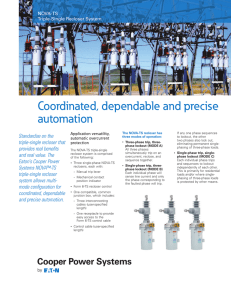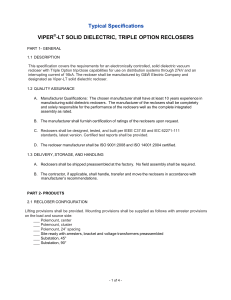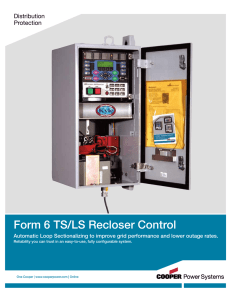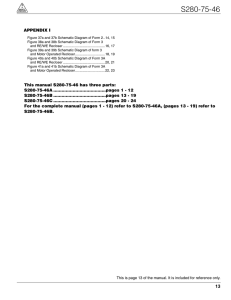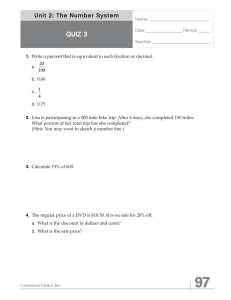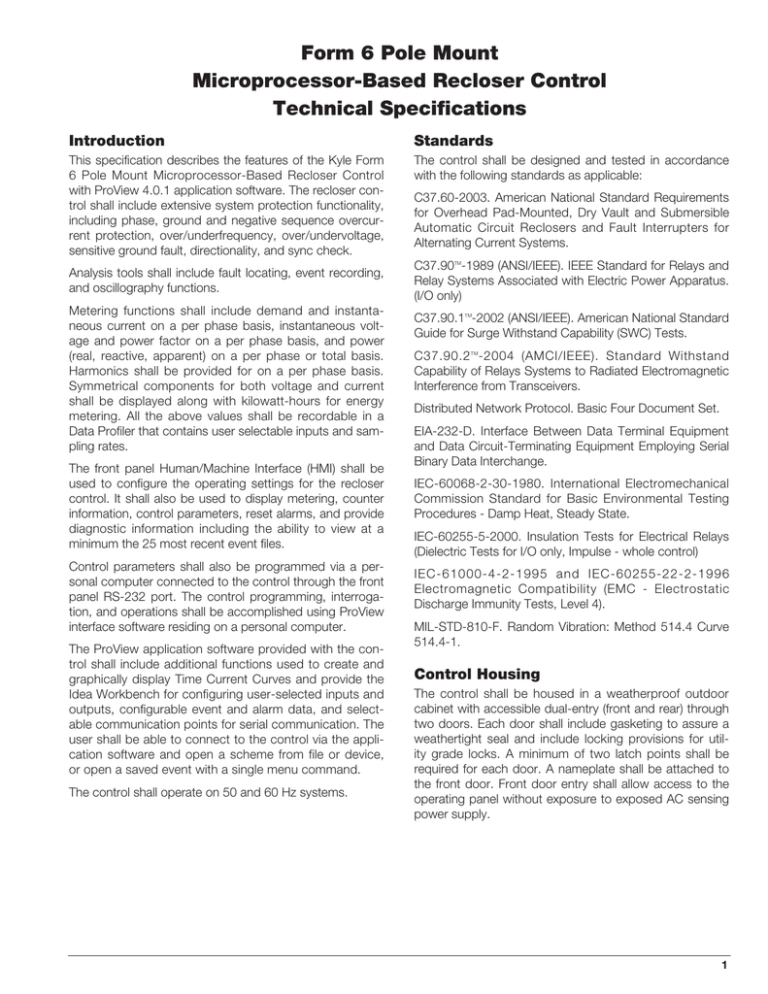
Form 6 Pole Mount
Microprocessor-Based Recloser Control
Technical Specifications
Introduction
Standards
This specification describes the features of the Kyle Form
6 Pole Mount Microprocessor-Based Recloser Control
with ProView 4.0.1 application software. The recloser control shall include extensive system protection functionality,
including phase, ground and negative sequence overcurrent protection, over/underfrequency, over/undervoltage,
sensitive ground fault, directionality, and sync check.
The control shall be designed and tested in accordance
with the following standards as applicable:
Analysis tools shall include fault locating, event recording,
and oscillography functions.
Metering functions shall include demand and instantaneous current on a per phase basis, instantaneous voltage and power factor on a per phase basis, and power
(real, reactive, apparent) on a per phase or total basis.
Harmonics shall be provided for on a per phase basis.
Symmetrical components for both voltage and current
shall be displayed along with kilowatt-hours for energy
metering. All the above values shall be recordable in a
Data Profiler that contains user selectable inputs and sampling rates.
The front panel Human/Machine Interface (HMI) shall be
used to configure the operating settings for the recloser
control. It shall also be used to display metering, counter
information, control parameters, reset alarms, and provide
diagnostic information including the ability to view at a
minimum the 25 most recent event files.
Control parameters shall also be programmed via a personal computer connected to the control through the front
panel RS-232 port. The control programming, interrogation, and operations shall be accomplished using ProView
interface software residing on a personal computer.
The ProView application software provided with the control shall include additional functions used to create and
graphically display Time Current Curves and provide the
Idea Workbench for configuring user-selected inputs and
outputs, configurable event and alarm data, and selectable communication points for serial communication. The
user shall be able to connect to the control via the application software and open a scheme from file or device,
or open a saved event with a single menu command.
The control shall operate on 50 and 60 Hz systems.
C37.60-2003. American National Standard Requirements
for Overhead Pad-Mounted, Dry Vault and Submersible
Automatic Circuit Reclosers and Fault Interrupters for
Alternating Current Systems.
C37.90 -1989 (ANSI/IEEE). IEEE Standard for Relays and
Relay Systems Associated with Electric Power Apparatus.
(I/O only)
TM
C37.90.1 -2002 (ANSI/IEEE). American National Standard
Guide for Surge Withstand Capability (SWC) Tests.
TM
C37.90.2 -2004 (AMCI/IEEE). Standard Withstand
Capability of Relays Systems to Radiated Electromagnetic
Interference from Transceivers.
TM
Distributed Network Protocol. Basic Four Document Set.
EIA-232-D. Interface Between Data Terminal Equipment
and Data Circuit-Terminating Equipment Employing Serial
Binary Data Interchange.
IEC-60068-2-30-1980. International Electromechanical
Commission Standard for Basic Environmental Testing
Procedures - Damp Heat, Steady State.
IEC-60255-5-2000. Insulation Tests for Electrical Relays
(Dielectric Tests for I/O only, Impulse - whole control)
IEC-61000-4-2-1995 and IEC-60255-22-2-1996
Electromagnetic Compatibility (EMC - Electrostatic
Discharge Immunity Tests, Level 4).
MIL-STD-810-F. Random Vibration: Method 514.4 Curve
514.4-1.
Control Housing
The control shall be housed in a weatherproof outdoor
cabinet with accessible dual-entry (front and rear) through
two doors. Each door shall include gasketing to assure a
weathertight seal and include locking provisions for utility grade locks. A minimum of two latch points shall be
required for each door. A nameplate shall be attached to
the front door. Front door entry shall allow access to the
operating panel without exposure to exposed AC sensing
power supply.
1
Form 6 Pole Mount Microprocessor-Based Recloser Control
Rear door entry shall allow direct access to all control
wiring including voltage connections, thermostaticallycontrolled heater, serial communications/hardwired inputs
and outputs. As part of the housing, a factory-mounted
and pre-wired control receptacle shall allow the user a
quick-disconnect from the recloser. The control housing
shall also have a provision for standard conduit or cable
entry. Two vent holes shall be included to maintain ventilation.
The control shall have a standard 15 Watt thermostatically-controlled heater (ON 70°F, OFF 85°F) for humidity
control. The heater shall be powered from the power supply board.
Configuration Firmware/Interface
Software
The recloser control shall use a Windows ® operating
system-based interface software. The software, ProView,
shall be separate from the recloser control. The executable configuration interface software shall allow the user
the ability to save and edit files based upon user requirements independent of connectivity to the control. All
settings, metering, and analysis tools shall use standard
dialog boxes, including available minimum and maximum
values, for each setting.
Firmware upgrades shall be available through direct connection to the dedicated RS-232 port on the control front
panel without any additional equipment required.
Temperature Range
The operating range of the control shall be -40°C to
+70°C ambient.
The enclosure design shall allow internal self-heating to
raise the enclosure interior an additional 15°C, such that
all components, assemblies, and sub-assemblies shall
operate from -40°C to +85°C. All components selected in
the design of the control shall have a temperature rating of
-40°C to +85°C. Validation of temperature range through
production sorting is not acceptable.
The control shall not be damaged by storage at ambient
temperatures from -40°C to +85°C.
Front Operating Panel
The Front Operating Panel shall be intuitively-designed to
minimize training costs and avoid potential misoperation.
The operating panel shall be separated into two sections
clearly identified by color-coding or another acceptable
user-approved method. The top portion of the control
shall be used for programming the control. The lower portion of the control shall be used for operation. The recloser
control shall be integrated as a system to include proper
status of the recloser on the front operating panel.
2
Programming/Status
The control programming section shall allow the user LED
status indication. Each LED shall be rated for visibility in
bright sunlight. The control shall have a total of thirty LEDs
available for direct control and recloser status information.
As a minimum, dedicated LEDs shall include status indication as follows:
•
•
•
•
•
•
•
•
•
•
•
•
•
•
•
•
•
•
•
•
•
•
•
•
•
Control OK
Control Power
Control Lockout
Recloser Open
Recloser Closed
A-Phase Fault
B-Phase Fault
C-Phase Fault
Ground Fault
Sensitive Ground
Alarm
Above Minimum Trip
Indicator 1
Indicator 2
Indicator 3
A-Phase Voltage
B-Phase Voltage
C-Phase Voltage
Frequency Trip
Voltage Trip
Indicator 4
Indicator 5
Indicator 6
Indicator 7
Indicator 8
The user shall be enabled to remove all insert labels (a
total of 31 relabeled LEDs) to customize the LEDs as
required. Removable labels shall be included with the
control to enable the user to easily customize the control
for their protection requirements. Removable inserts shall
be available to customize LEDs for all 9 Option LEDs and
all Target Indicators except CONTROL OK, CONTROL
POWER, AND ALARM. Removable inserts and labels shall
be designed to enable the user to change inserts without
the use of adhesives, labelmakers, or temporary labels.
The user shall have the ability to access critical operation
functions through the use of eight Analysis One-Touch
Keypads. It shall not be acceptable to scroll through a
series of menus for the following functions:
•
•
•
•
•
•
•
•
Metering
Reset Targets
Events
Lamp Test
Settings
Operations Counter
Alarms
Change
Technical Specifications
A sharp, backlit 4 line x 20 character display shall be
included in the programming section. The LCD panel contrast shall be field-adjusted to allow for various mounting
heights and applications. The LCD shall provide extensive status information regarding the distribution system,
recloser, and control using a minimum of eight navigational keypads in an organized menu structure. The navigational keypads shall include accelerated plus and minus
keypads for quick setting changes; direct scroll up, down,
left, and right keypads; along with immediate enter and
menu keypads for direct operation. The LCD shall also
use four clearly-identified function keys for setting and
operation instructions.
Operating Power
The programming section shall also include a DB-9
RS-232 connector for direct connection to a personal
computer (PC). The interface shall be designated DCE to
directly connect to the serial port of the PC without any
special cables or connectors.
• Positive LED indicator for power supply presence.
Operating Section
The control shall have a standard 15 Watt thermostatically-controlled heater (ON 70°F, OFF 85°F) for humidity
control and voltage input independent. The heater shall be
powered from the power supply board.
The operating section shall allow the user direct open and
close operation of the recloser along with pre-defined and
customized operating functions.
Incoming AC power shall be routed to the Power Supply/
Battery Charger Board from either 120 Vac or 240 Vac.
The battery charger shall include a temperature-compensated design to optimally charge the control battery. The
power supply/battery charger board shall also include an
auxiliary power supply for connection to communication
equipment (radios, modems, etc.). The auxiliary power
supply shall be rated 28 Vdc, 65 Watts peak. A separate
28 Vdc to 13.8 Vdc power supply accessory shall be
available for communication equipment rated for 12 Vdc.
Some additional features shall be included as follows:
• Selectable 120/240 Vac switch for adapting to multiple
transformer connections. The selector switch shall be
factory-set based upon each customer order.
• Self-protective fuse (5 amp, 250 Vac).
The TRIP and CLOSE buttons shall have a minimum surface area of one square inch (6.45 cm2) with a protective
guard around the perimeter of each button to prevent
incidental trip or close. The TRIP button shall be green
and the CLOSE button shall be red. No exceptions to the
surface area or color of the TRIP and CLOSE button standards shall be accepted.
The control shall be equipped with either an 8 Amp-Hour
or 13 Amp-Hour 24 Vdc lead acid battery for operation upon loss of AC power. The battery shall have a life
expectancy of four to six years. The control shall maintain
full operation from the battery for a period of time dependent upon the battery size:
The TRIP button shall be hardwired to the recloser independent of the microprocessor. All trip commands from
the TRIP Button shall trip the recloser, even in the event of
a microprocessor failure.
• 13 Amp-Hour — 25 hour maximum (20°C)
The CLOSE button shall be connected to the microprocessor for establishing temporary operating requirements
such as cold load pickup.
The front operating panel shall include the following pushbutton keypads with LED Indicators:
•
•
•
•
•
•
•
•
•
Ground Trip Blocked
Non-Reclosing
Supervisory Off
Alternate Profile #1
Alternate Profile #2
Alternate Profile #3
Option #1
Option #2
Option #3
The front operating panel shall also include the following:
•
•
•
•
• 8 Amp-Hour — 15 hour maximum (20°C)
In the event that the AC power has not returned within the
times listed above, the control shall disconnect the battery
from the circuit.
The control shall continuously monitor the battery voltage.
To prevent battery damage, the control shall shut down
automatically upon detection of low battery voltage (below
22 Vdc) for 60 seconds.
Control programming settings and parameters—including
event recorder—shall be stored in non-volatile memory
and retained upon loss of control power. The time/date
clock shall continue to operate for approximately 30 days
after loss of control power.
Phase B (Ø) shall be the factory default phase. Unless
changed by the user, the B PHASE VOLTAGE red LED
shall illuminate indicating AC is the operating power. If BØ
(or the user-indicated phase) loses AC power, the ALARM
red indicator LED shall illuminate. The ALARM log on the
LCD Display shall indicate NO AC PRESENT.
Hot Line Tag On/Off Toggle Switch
Hot Line Tag LED Indicator
Close Circuit Disable removable link
RS-232 Port
3
Form 6 Pole Mount Microprocessor-Based Recloser Control
Terminal Blocks
Protection Profiles
Two terminal blocks shall be used for connection to the
recloser control. Both terminal blocks shall be fit for a #6
screw which shall allow a maximum ring size for a #10
AWG wire.
Four protection profiles shall be provided, each capable
of fully specifying the operation of the control. The profiles shall be selected from front push-button overlays
or through interface software and serial communication
ports. Each protection profile shall include the following as
a minimum:
Power Connections
The transformer required for power shall have a minimum
of 5kVA for low-voltage AC closing reclosers and 1kVA for
high voltage AC closing reclosers and NOVA-DC reclosers.
Protocols
Four serial communications protocol options shall be supported in the control.
•
•
•
•
Modbus
DNP3
2179
IEC 870-5
The protocol ports are configured as follows:
• Front Panel Port – This port shall be used exclusively
with the ProView interface software supplied with the
control.
• Rear Panel Ports (2 – Standard supplied RS232 and 1
that is user selectable at time of order) – The rear port
selections shall be:
• RS-485 (Isolated)
• Serial Fiber Optic
• Ethernet (Wire or Fiber)
• The user shall configure which back port shall have the
communication protocol. The other port shall automatically be assigned ProView protocol.
The RS-485 or serial fiber-optic communications cards
shall not support ProView protocol.
Control Security
• The control shall have a customer-programmable
security code to limit access of control programming
and viewing functions to authorized personnel.
• There shall be a connection password when communicating between the control and a computer.
•
•
•
•
•
•
•
Overcurrent Protection
Over and Undervoltage Protection
Over and Underfrequency Protection
Directional Protection
Sync Check
Sensitive Ground Fault Protection
Operation Settings
Time-Current Curve
Time-current curves shall be available for fast and delayed
operations. Each time-current shall be selected from a
defined fifty curves which can be further customized by
the user. The time-current curves shall also be selected
from a graphical TCC editor to visualize any modifications
prior to configuring the control.
The time-current curves shall include the following modifications for phase, ground, and negative sequence protection:
• Time Multiplier with a range of .1 to 25 in .1 increments.
• Time Adder with a range of 0 to 30 seconds in .01
second increments.
• Minimum Response Time with a range of 0 to 1 seconds in .001 second increments.
• High Current Trip with a range of 1 to 32 multiples of
minimum trip.
• HCT Time Delay with a range of .016 to .150 second in
.001 second increments.
Sequence Coordination
A Sequence Coordination feature shall be included which
allows the control to step through selected operations in
the operating sequence without tripping. The number of
Sequence Coordination advances is programmable from
one to three operations to provide trip coordination with
a downline recloser. This feature shall be independently
selectable for each protection profile.
Cold Load Pickup
The control shall include a Cold Load Pickup feature to
prevent the control from tripping due to inrush current.
This feature shall have an independently programmable
minimum trip value, time-current curve, reclose interval,
and number of operations to lockout for each protection
profile.
4
Technical Specifications
Hot Line Tag
• Instantaneous power factor on a per phase basis.
A Hot Line Tag feature to block all closing operations for
live-line work shall be included in the design of the control
as a standard feature. When selected, the control shall trip
on one operation to lockout on the composite curve of the
Hot Line Tag definite time and the TCC1 curve (whichever
is faster). Hot Line Tag time delay shall be independently
selectable for each protection profile.
• Metering settings to include demand interval, and
alarm thresholds for current, single-phase kW, threephase kW, single-phase kVAr, and three-phase kVAr.
Fast Trips Disabled
The control shall include a Fast Trips Disabled feature to
modify the protection, so that all trip operations use the
programmed TCC2. This feature shall be independently
selectable for each protection profile. The total trip operations shall remain the same. As an example, the control
shall change it’s sequence from two fast and two delayed
operations to four delayed operations when Fast Trips
Disabled is active.
High Current Lockout
An onboard Data Profiler shall be provided to record user
configured demand values. These values will be taken at
a user selectable sampling rate. Based on the number of
values recorded the Data Profiler should be able to record
a minimum of 30 days worth of data.
Data Profiler
The Data Profiler shall record configurable analog data for
a specific period of time. The Data Profiler shall be configured to allow periodic recording with ranges from 1 minute
to 24 hours for all selected parameters. The Data Profiler
shall be capable of selecting up to 150 analog data points
along with 8 user-customized analog data points. The
data profiler shall present the data in table form and allow
exporting to external spreadsheet application software.
A High Current Lockout feature that will automatically
lockout the control when current exceeds a programmable
level shall be included in the control. The active shot numbers for the lockout shall be selectable for phase, ground,
and negative sequence. Also, direct values, not multiples
of minimum trip, shall be provided. This feature shall be
independently selectable for each protection profile.
Event Recorder
Sensitive Ground/Earth Fault Operation
Some factory-defined event types shall be as follows:
The recloser control shall contain capabilities to perform
Sequence of Events for up to 33 event types. The event
recorder shall include the date and time of the event and
appropriate metering analogs based upon event type.
Sixteen additional event types are user-defined through
the Idea Workbench.
The control shall include a Sensitive Ground/Earth Fault
Trip feature that will provide tripping of the recloser for
ground currents below normal ground minimum trip levels. The feature shall have programmable operations to
lockout and reclose intervals independent of the ground
settings. This feature shall be independently selectable for
each protection profile.
• Overcurrent Protection Trip
Metering
The Event Recorder shall maintain a minimum of 90
events.
The control shall provide instantaneous and/or demand
metering with programmable integration intervals for the
following functions:
• Real and reactive power for each phase and total,
including directional, on an individual phase basis.
• Demand currents on a per phase basis.
• Instantaneous currents, including ground current.
• Instantaneous voltage on a per phase basis.
• External Trip
• Non-Reclose Trip
• External Close
• Lockout
• Reset
Recloser Duty Monitor
The recloser control software shall be equipped with a
Recloser Interrupting Duty Monitor. The Duty Monitor
shall accumulate the summation of I1.5 for all interrupted
currents on each interrupter. This feature shall permit
programmable entries to preset the duty of an existing
recloser.
• Instantaneous frequency.
• Positive, negative, and zero sequence voltages.
• Harmonics on a per phase basis for voltage and current.
5
Form 6 Pole Mount Microprocessor-Based Recloser Control
Discrete SCADA Communications
The control shall provide a minimum of five configurable
output status contacts. Each status contact shall be configurable using graphical interface software to combine
status functionality along with Boolean algebra. Default
output status shall be: Lockout, Open, Close, Ground Trip
Block, and Hot Line Tag. One output status contact shall
be a solid state output with a pickup time no longer than
two milliseconds.
The control shall also provide a minimum of three configurable control input contacts. Each control contact
shall be configurable using a graphical interface software.
Each contact shall accept a voltage range of 12-240
Vac, 12-250 Vdc as the whetting voltage. Each control input shall be configured for either a momentary,
latched, or latched with precedence contact. Default control input contacts shall be: Supervisory Trip and Lockout,
Supervisory Close, and Remote Trip and Lockout.
A Discrete Interface Board shall also be available as an
accessory to provide an additional eight output status
contacts and eight control input contacts. The Discrete
Interface Board shall be user-configurable via the Idea
Workbench.
Time Current Curve Editor
Coordination and actual time current modifications shall
be available with a graphic interactive Time Current Curve
Editor or similar graphical software.
The Time Current Curve Editor shall include a complete
database of standard industry recloser time current curves
(TCC), both ANSI and IEC types, along with the ability to
customize the TCCs with multipliers, constant time adders,
or minimum response time adders. Also, the user shall be
able to derive their own specific TCC through data point
entry. Each modified time current curve shall be able to
be identified with a user-customized name and shall be
selectable for configuring the control. The grid and format
for presenting the TCCs shall have a user-adjustable scale,
including the option of presenting multiple TCCs in various
user-configured colors.
Oscillography
Oscillography shall be provided to present current and
voltage waveforms, along with protection function and
recloser response status changes.
6
The recorded values shall be super-imposed on the protection scheme, and the state or value at any point in the
scheme shall be displayed. The user shall have the capability to move through the event and watch the response
of all available functions. All analog signals, digital inputs,
and contact outputs shall be monitored. The oscillography sampling rate shall be a minimum of 16 samples per
cycle. The oscillography data on the analog signals shall
be post-filtered values. Event size shall be user selectable
from 2 to 30 cycles with the capability of recording a minimum of 20 events for a 12 cycle event.
Idea Workbench
The Idea Workbench application included with the control interface software shall allow the user to program the
control using simple graphical logic characters, internal
alarms, status, and target. The user shall have the ability
to perform logical functions with a combination of these
variables using drag and drop functionality supported by
the control.
The Idea Workbench shall provide a true graphical programming environment. Logical equation programming
shall not be acceptable.
Over/Undervoltage Protection
The control shall include single-phase and three-phase
undervoltage tripping. The control shall also include threephase overvoltage tripping. Both over and under voltage
functions shall include a phase pickup, a phase time
delay, a three-phase pick-up, and a time delay. Voltage
protection shall be included as part of each protection
profile.
Over/Underfrequency Protection
The control shall include two-stage operation for both
Underfrequency and Overfrequency protection. Frequency
protection shall have the ability to enable either over or
under frequency protection or both functions simultaneously. A fixed time delay ranging from 0 to 100 seconds
in .001 second increments shall be available for both over
and under frequency. A frequency voltage supervision
threshold with a range from 0 to 300 Volts in .1 Volt increments shall be included to prevent spurious frequency
trip operations. A frequency restoration function, enabled
or disabled by the user, shall be provided to allow the
recloser to automatically close should frequency return to
within configured settings for a user-settable time. Over/
Under Frequency Protection shall be included as part of
each protection profile.
Technical Specifications
Hardware Specifications
Directional
Directional functionality shall be included to maintain system coordination from multiple sources, as well as circuit
reconfiguration for each profile. Directional shall apply to
phase, ground, and negative sequence protection, selected independently. A maximum torque angle shall have a
range of 0–90 degrees in 1 degree increments.
Fault Location
The control shall include an impedance-based fault locator
based upon the Takagi algorithm. A load-compensated
impedance calculation shall be used for calculating the
distance. The user shall be able to configure the positive and zero sequence in ohms, and the fault locator line
length in kilometers and/or miles.
Sync Check
Sync Check functionality shall include the following applications:
•
•
•
•
Hot Line/Hot Bus Closing
Dead Line/Hot Bus Closing
Hot Line/Dead Bus Closing
Dead Line/Dead Bus Closing
Sync Check Parameters shall include the following configurable settings:
•
•
•
•
•
•
•
•
•
•
•
Voltage Angle
Mechanism Operating Delay
Static Angle Delay
Dead Threshold
Live Threshold
Positive Sequence Dead Threshold
Upper Voltage Limit
Lower Voltage Limit
Lower Frequency Limit
Upper Frequency Limit
Fail to Close Timer
Frequency
50 / 60 Hz
Voltage Sensing Inputs
• 3 – 300 Vac (6 inputs)
• Each phase has a PT ratio and phase angle adjustment setting
• Burden < 0.1VA. Input impedance ~1Mohm
Control Power Supply
• 120/240 Vac ±15% , 350VA peak input power
Control Contact Inputs (OpticallyIsolated)
• 9 Vdc - 290 Vdc (default range)
• 7 Vac - 265 Vac (default range)
Status Contact Outputs
•
•
•
•
•
240 Vac / 250 Vdc
Make: 30 A peak, 8 A continuous
Break: 0.2 A peak
Pickup Time: <8ms
Dropout Time: <5ms
Solid-State Contact
•
•
•
•
•
240 Vac / 250 Vdc
Make: 30 A peak, 8 A continuous
Break: 10 A peak
Pickup Time: <2ms
Dropout Time: <15ms
Local/Remote Communications
• Two EIA-RS-232 serial ports
• Front Panel – Used exclusively with ProView protocol (DCE)
• Rear Port – Configurable to be either the default
SCADA protocol (DNP, 2179, Modbus, or IEC8705-101) or ProView protocol (DTE)
• RS-485 / Fiber daughterport – Can be configured
exclusively for any one of the SCADA protocols (DNP,
2179, Modbus, or IEC870-5-101) and, as a result, the
ProView protocol is active on the rear RS-232 port.
7
Form 6 Pole Mount Microprocessor-Based Recloser Control Technical Specifications
Baud Rate
Pole Mount Cabinet Dimensions
Protocol
Baud
Rate ProView Modbus 2179 DNP IEC870-5-101
1200
X
X
X
X
2400
X
X
X
X
X
4800
X
X
X
X
9600
X
X
X
X
X
19200
X
X
X
X
X
38400
X
X
X
X
X
57600
X
X
115200 X
Front Panel Display
4 x 20 LCD Display with LED Backlight, Contrast
Adjustable
Front Panel Targets
25 Single-Element High-Intensity LED Targets
• 22 are user-configurable.
Front Analysis Keypad
Eight Momentary Contact One-Touch Keypads for
Immediate System Analysis
345 mm (13.5 in) wide
710 mm (28 in) high
310 mm (12.25 in) deep
Operating Temperature
-40°C to +70°C ambient
IEC 68-2-1 & IEC68-2-2
Humidity Test
IEC 68-2-30
Impulse/Dielectric Test
IEC 255-5
Radio Frequency Interference
ANSI / IEEE C37.90.2 -1995 standard
IEC 61000-4-3 level X=35 V/M
IEC 61000-4-2 ESD, Level 4
IEC 61000-4-4 EFT, Level 4
IEC 61000-4-6 Conducted immunity, level 3
IEC 61000-4-11, voltage dips and interruptions [40% &
70% of nominal voltage]
TM
Surge Withstand
ANSI / IEEE C37.90.1 -2002 standard
ANSI/ IEEE C37.60 -2003 standard sec. 6.13.2
TM
TM
Front Panel Keypad and Controls
• Nine Momentary Contact One-Touch Keypads with
LED Indicators for Operating Functions
• All are user-configurable.
• Large TRIP and CLOSE Momentary Push-Buttons
• Hot-Line Tag Toggle Switch with High Intensity LED
Local Indication
Vibration/Shock Test
MIL-STD-810-F
IEC-255-21-1
IEC-255-21-2
©2008 Cooper US, Inc. All Rights Reserved
All Cooper logos, Cooper Power Systems, Kyle, ProView, and Idea Workbench are valuable trademarks of Cooper US, Inc., in the U.S. and other countries. You are not permitted to use Cooper trademarks without the prior written consent of Cooper US, Inc.
Windows® is either a registered trademark or trademark of Microsoft Corporation in the
United States and/or other countries.
IEEE Standards C37.60TM-2003, C37.90TM-1989, C37.90.1TM-2002, and
C37.90.2TM-2004 are trademarks of the Institute of Electrical and Electronics Engineers,
Inc. This product is not endorsed or approved by the IEEE.
Bulletin B280-00032 • October 2008 • Supersedes 11/03
2300 Badger Drive
Waukesha, WI 53188
www.cooperpower.com

